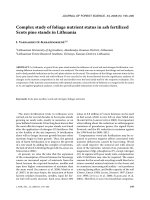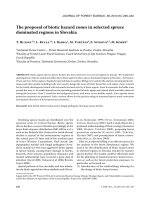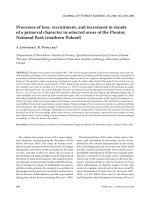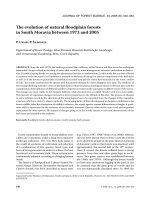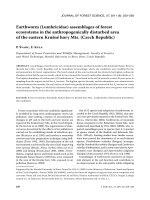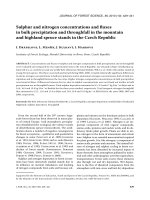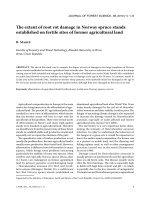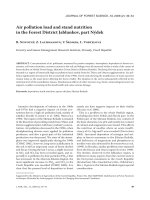Báo cáo lâm nghiệp: "Which factors explain lepidopteran larvae variance in seasonal guilds on some oaks" pptx
Bạn đang xem bản rút gọn của tài liệu. Xem và tải ngay bản đầy đủ của tài liệu tại đây (667.75 KB, 9 trang )
68 J. FOR. SCI., 56, 2010 (2): 68–76
JOURNAL OF FOREST SCIENCE, 56, 2010 (2): 68–76
e study of forest insect communities is of inter-
est to ecologists worldwide. As mentioned by L-
and W (1996), forest canopies contain
a considerable portion of the species diversity on
Earth. us, an understanding of the variables that
determine species richness and composition should
have a high importance for both theoretical and
practical reasons. However, the completion of a reli-
able inventory list of canopy communities requires
exhaustive mass-sampling (S et al. 1997).
Although descriptive studies have dominated
canopy arthropod research, some recent studies
have focused on statistical testing of hypotheses:
e.g. vertical and seasonal variation in communities
(S, G 1998); several other studies
were conducted to compare the community struc-
ture of Lepidoptera within and between various tree
species (N, N 1983; K 1990;
S et al. 2003).
Insect communities have also been used to esti-
mate levels of forest disturbance (T-S
et al. 2003), and as a conservation tool to determine
the value of natural reserves (G, C 2003).
In European forests the interspecific difference
among host trees has been identified as a significant
factor influencing the macrolepidopteran species
richness. For example, a significant difference in
caterpillar diversity was found between Betula sp.
and Fraxinus sp., and also among other tree genera in
Finnish forests (N, N 1981, 1983).
In North America B et al. (2000) compared
caterpillar faunas from Salix nigra and Acer negundo
Which factors explain lepidopteran larvae variance
in seasonal guilds on some oaks?
M. T
1
, J. P
1†
, M. K
2
1
Faculty of Forestry and Wood Sciences, Czech University of Life Sciences Prague, Prague,
Czech Republic
2
Department of Ecology, Comenius University, Bratislava, Slovakia
ABSTRACT: Differences between the oak lepidopteran communities were studied in Slovakia in 1993 and 1994. Sam-
pling was undertaken between April and October on 3 oak species. Biological traits of larvae were examined in order
to explain differences in seasonal guilds among oaks. Cluster analysis shows similarities between communities in the
flush feeder guild where the results were influenced mainly by temporal variability; in the late spring guild mainly by
site; factors influencing summer feeder and autumn feeder similarities remain unclear. Detrended Correspondence
Analysis (DCA) was used to investigate the main gradients explaining variability in communities. Results indicated
that the host specificity along axis 1 (A1) and larval ballooning along axis 2 (A2) were important in the flush feeder
guild; larval feeding strategy along A1 and the degree of defoliation by Lymantria dispar along A2 were important
in late spring feeders; the year of study along A1 and host specificity along A2 were important in the summer feeder
guild; and adaptation to lower quality of food along A1 and host specificity along A2 for the autumn feeder guild. e
results are discussed.
Keywords: cluster analysis; DCA; history-life traits of lepidopteran larvae; oaks; seasonal guilds
Supported by the Ministry of Agriculture of the Czech Republic, Project No. QH 71094, and partially by the Scientific Grant Agen-
cy (VEGA) of the Ministry of Education of the Slovak Republic and the Slovak Academy of Sciences. Grant No. 1/0155/08.
J. FOR. SCI., 56, 2010 (2): 68–76 69
and confirmed a high proportion of caterpillars were
host species specific. However, S et al.
(2003) argues that the degree to which species diver-
sity found on any particular host tree varies due to
random chance is unknown.
Despite the fact that oaks are a widely distributed
group of trees with over 300–600 species world-
wide (T-S et al. 2003) and that they
usually support a high abundance and diversity of
insect species (S et al. 2003), studies
on the arthropod fauna of oaks are relatively scarce
(T-S et al. 2003).
Even less is known about host specific guild rich-
ness and factors that influence the annual variation
in lepidopteran communities.
N and H (1982) studied lepidop-
teran species diversity on Finnish deciduous trees,
and based on the availability of food resources in
late summer they were able to define two main host
tree groups. In addition experiments conducted in
their study confirmed the importance of the host
tree in determining the richness of seasonal guilds.
S and G (1998) found distinguish-
able arthropod communities on four coniferous tree
species. ey found significant differences between
early (June) and late (August) seasons that explained
(jointly with the canopy level) a high proportion of
the variation in arthropod assemblages. In Mexico
T-S et al. (2003) described significant
seasonal differences between lepidopteran com-
munities on different oaks. Generally, the species
diversity was higher in the rainy than in the dry
season. S and C (2003) and S-
et al. (2003) confirmed significant com-
positional differences in moth communities sampled
between early and late season. S et al.
(2003) found that the clustering of lepidopteran as-
semblages, on four deciduous trees, between early
(June–July) and late (August–September) seasons
was quite different. Differences in the phenology
of lepidopteran species were considered the most
significant factor affecting the similarity of caterpil-
lar fauna (early and late season samples were only
18% similar). K and D (1999) found that
communities in May had the highest species richness
during both years of study, the maximum was found
only occasionally in June.
There are several hypotheses why tree species
sustain various communities of Lepidoptera. Previ-
ously, the pattern of associations between herbiv-
ores and their host plants has been considered as
relationships between the quality of plants as food
resources (E, R 1964; C 1980), or
as a result of plant nutrient composition (S,
F 1979), plant defence mechanisms (C-
1981; B 1997) and phenology (W,
K 1990). e assumption of high host specificity
with studies revealing a lesser degree of high host
specificity (N, N 1983) or a high
level of herbivore specificity has also been tested.
e theory of available food resources (N,
H 1982) suggests that the herbivore com-
munity diversity strongly depends on the type of tree,
for example the Quercus type where new leaves are
available for only a short time early in the season or
the Populus type where new leaves are available all
season. L et al. (2002) studied host plant–herbiv-
ore–parasitoid interactions and found that the host
plant was the main variable influencing levels of
lepidopteran parasitism. N and N
(1981) showed that host frequency, height and the
number of relative host species explained a high
proportion (71%) of lepidopteran species richness
variance. F et al. (2004) highlighted the role
of tannin as an anti-herbivore defence on two oak
species across seasons.
Our effort was focused on understanding the
mechanisms that explain variance in lepidopteran
communities in various seasonal guilds on different
oaks. e main study goal was: to analyze the main
life-history traits of lepidopteran larvae and other
parameters that may explain species variance in
seasonal guilds on different oak species via cluster
analysis and ordination method.
STUDY SITES AND METHODS
Fundamental information about methodology
of sampling, site description, and the separation
of species to seasonal guild is in T et al.
(2009).
In statistical analyses we used cluster analysis
(Ward’s procedure, Euclidean distances), STATIS-
TICA 5 to compare differences between study sites
using species abundance in seasonal assemblages.
Prior to analysis, abundance data were transformed
as log(x + 1).
Cluster analysis was performed on several diffe-
rent datasets:
(a) Twenty of the most abundant species the year
round;
(b) Fifteen of the most abundant species classified as
FlF;
(c) Ten of the most abundant species classified as
LSF;
(d) All 10 species classified as SF;
(e) Five of the most abundant species classified as
FaF.
70 J. FOR. SCI., 56, 2010 (2): 68–76
Subsequently, we compared species assemblages
using Detrended Correspondence Analysis (DCA),
a method of ordination, which is an indirect gradient
method. Values were detrended by segments, with a
square root transformation using CANOCO 4.5 (T
B, Š 2002). Results were plotted as
biplot data with the scores for study sites, species and
the main estimated gradients for two of the first axes
in each of the seasonal guilds. Estimating the main
gradients was done by the inspection of caterpillar
life history traits and/or environmental parameters in
relation to the DCA diagram. DCA was performed for
the same datasets as in cluster analysis except for (a)
Twenty of the most abundant species the year round.
RESULTS
Cluster analysis results
e cluster analysis of year round guilds (Fig. 1a)
indicated a high similarity of Quercus robur stands,
and a low similarity between Q. robur and the other
two oak species. All guilds were clearly connected with
studied oaks and there was an indication in the case of
Q. robur that temporal rather than spatial variability
played a greater role in guild clustering. is suggests
that the communities were probably influenced more
by stochastic factors like weather, enemies or com-
petition than by the ecological parameters of stands.
Among the 20 species taken for analysis 13 belonged
to the FlF guild, five to LSF and two to FaF. No SF data
were entered into this analysis, because of the low
abundance of species feeding during summer.
Results of the cluster analysis of FlF data (Fig. 1b)
were similar to those for the year round guild on
Q. robur. Temporal variability also appeared more
significant than the impact of the site (host tree).
Communities on two different sites were grouped
together by year, grouping by the same sites in dif-
ferent years was not found. A similar situation was
found in the case of Q. petraea and Q. rubra where
temporal variability also played a greater role in
grouping the sites. is result indicates that dif-
ferences between native (planted) and non-native
host tree stands played a less important role than
differences in conditions in various years. is clus-
ter analysis reflects the situation at the beginning
of the season, which is characterized by a lack of
food if late frosts damage foliage (P, Č
1971).
LSF were clustered by host tree, and similarity
of guilds on the same host tree was always higher
(Dlink/Dmax)*100
Q.petraea 94
Q.petraea 93
Q.robur2 94
Q.robur1 94
Q.robur2 93
Q.robur1 93
Q.rubra 94
Q.rubra 93
0 20 40 60 80 100
(Dlink/Dmax)*100
Q.robur2 94
Q.robur1 94
Q.robur2 93
Q.petraea 94
Q.rubra 94
Q.robur1 93
Q.rubra 93
Q.petraea 93
0 20 40 60 80 100
(D lin k/D m a x)*1 0 0
Q.robur2 93
Q.rubra 93
Q.rubra 94
Q.petraea 94
Q.robur2 94
Q.robur1 93
Q.robur1 94
Q.petraea 93
10 20 40 60 80 100
Q.petraea 94
Q.petraea 93
Q.rubra 93
Q.rubra 93
Q.robur1 94
Q.robur2 94
Q.robur2 93
Q.robur1 93
0 20 40 6 0 8 0 100
(Dlink/Dmax)*100
Q.robur2 94
Q.robur1 94
Q.robur2 93
Q.robur1 93
Q.petraea 94
Q.rubra 94
Q.rubra 93
Q.petraea 93
0 20 40 60 80 100
(Dlink/Dmax)*100
Q. petraea 93
Q. rubra 93
Q. rubra 94
Q. petraea 94
Q. robur1 93
Q. robur2 93
Q. robur1 94
Q. robur2 94
0 20 40 60 80 100
(Dlink/Dmax) × 1,000
Q. robur1 93
Q. robur2 93
Q. robur2 94
Q. robur1 94
Q. rubra 93
Q. rubra 93
Q. petraea 93
Q. petraea 94
0 20 40 60 80 100
(Dlink/Dmax) × 1,000
Q. petraea 93
Q. petraea 94
Q. rubra 93
Q. rubra 94
Q. robur1 93
Q. robur2 93
Q. robur1 94
Q. robur2 94
0 20 40 60 80 100
(Dlink/Dmax) × 1,000
Q. petraea 93
Q. rubra 93
Q. robur1 93
Q. rubra 94
Q. petraea 94
Q. robur2 93
Q. robur1 94
Q. robur2 94
0 20 40 60 80 100
(Dlink/Dmax) × 1,000
Q. petraea 93
Q. robur1 94
Q. robur1 93
Q. robur1 94
Q. petraea 94
Q. rubra 94
Q. rubra 93
Q. robur2 93
0 20 40 60 80 100
(Dlink/Dmax) × 1,000
Fig. 1. Cluster analysis of guilds depending on the seasonality:
(a) Year round guild; (b) Flush feeders; (c) Late spring feeders;
(d) Summer feeders; (e) Autumn feeders
(a) (b)
(c)
(d)
(e)
J. FOR. SCI., 56, 2010 (2): 68–76 71
than among different host trees (Fig. 1c). e results
suggested that the host tree played a greater role in
the similarity of this guild than temporal variability.
However, the similarity of guilds in the Q. robur clus-
ter was determined more by temporal variability.
Clustering the guilds of SF was quite different from
previous patterns (Fig. 1d). Summer is a time when
the abundance of Lepidoptera larvae on oaks was the
lowest during the vegetation season in our study at
majority. Oak species showed only the presence of
0–4 species in 1993 and 2–7 species in 1994 per site.
e number of individuals per 25 beatings (about
2,500 leaves) varied from 0 to 8 larvae in 1993 and
from 2 to 24 larvae in 1994 per site. All 10 species
(two of them with abundance of 1 larva per all sites)
were taken to be analyzed. We also performed the
analysis without rare species but the result of cluster-
ing was almost the same. Sites covered by Q. robur
in 1994 are clearly separated from all other sites, so
the year 1994 played a greater role on these sites. e
abundance of larvae was much higher on these 2 sites
than on all other sites. All other sites formed a big
cluster combining variable sites. Guilds on various
oak species were similar and the temporal variability
did not play a visible role in these stands.
e results of FaF cluster analysis seem to be also
influenced by the low abundance of species. Only
5 species were taken for analysis and it is possible to
recognize 3 clearly defined groups.
(1) Guild on Q. robur 2 in 1993 was separated as the
most abundant one;
(2) Cluster combining other Q. robur sites with the
richer Q. petraea site;
(3) Cluster of Q. rubra with Q. petraea in 1994
(Fig. 1e).
ere were no clear indications that the similar-
ity of communities was influenced by food tree or
temporal variability.
Detrended Correspondence Analysis results
e first two axes of Detrended Correspondence
Analysis (DCA) (Fig. 2a) revealed the main gradi-
ents which form FlF communities. Two of the first
axes explained 46.7% of species variance. ere are
two slightly overlapping clusters of sites along axis
1 (DCA-1, Fig. 2a).
ese are:
(1) Planted stands of
Q. petraea and Q. rubra;
(2) Well defined groups of
Q. robur sites. e main
ecological gradient along DCA-1 relates to the
host specificity of FlF, which consists of three
main groups:
(a) polyphagous species overwintering as eggs
(Lymantria dispar, Cosmia trapezina, Epirrita
diluta, and Operophtera brumata) from the left
of axis 1 to its centre;
(b) oligophagous species in the central zone of axis
one (Lithophane ornitopus, Agriopis marginaria
and Ypsolopha ustella);
(c) relatively specialized species feeding only on
oaks or only on some of the oak species (Neo-
zephyrus quercus, Nycteola revayana, and Tor-
trix viridana).
Species in the 1
st
group are associated with Q. rub-
ra, species of the 2
nd
group with Q. petraea and
Q. robur and species from the 3
rd
group with
Q. robur
, but also Q. petraea. Species in the second
group generally overwinter as pupae or adults,
species of the third group as eggs (T. viridana,
N. quercus
) or adults (N. revayana). Another pos-
sible mechanism impacting the species variability is
the timing of leaf flush. During this study Quercus
robur was the earliest to present new leaves, fol-
lowed by Q. rubra and lastly Q. petraea.
The presence/absence of wind-borne dispersal
(known only for a minority of species involved in
this analysis) was identified along axis 2 (DCA-2,
Fig. 2a). ere is only one species using ballooning
on the bottom part of axis 2 (Agriopis leucophaeria),
but there are several species on the upper part of
axis 2 (
L. dispar, A. marginaria, Colotois pennaria,
and O. brumata). All these species are the main ele-
ments of the FlF guild on Q. rubra.
e FlF guild on Q. robur is characterized by a high
incidence of specialized species (we do not consider
miners) which occasionally occur also on Q. petraea.
e communities on Q. rubra are composed of bigger
species that are able to use wind-borne movement.
Two of the first DCA axes explained 66.8% of species
variance in LSF. ey revealed possible mechanisms
which explain the species variance in this season.
Along axis 1 (DCA-1, Fig. 2b) there are three slightly
overlapping site clusters. ese are clustered by host
tree, and communities in this season are quite distinc-
tively defined. e main gradient connected with axis
1 was feeding strategy (from left of axis 1 to the right:
skeletonizers and leaf miners, feeders under webs and
among spun leaves and free feeders). Free feeding lar-
vae at this time use mimicry as a strategy of survival
and skeletonize leaves as young larvae. We mentioned
that leaf miners were not taken into consideration in
this study, but B. ulmella is a leaf miner during the
first larval stages and so later in development it is
sensitive to beat sampling. Skeletonizers were mainly
associated with Q. robur, the leaf architecture of
which is the most suitable to partial miners like Buc-
72 J. FOR. SCI., 56, 2010 (2): 68–76
-2 3
-2
3
Ypsolopha
Tortrix
Conobathra
Neozephyrus
Agriopisl
Agriopism
Alsophila
Colotois
Epirrita
Operophtera
Euproctis
Lymantria
Amphipyra
Cosmia
Eupsilia
Lithopane
Nycteola
Orthosiace
Orthosiacr
Orthosiai
Q.pe93
Q.pe94
Q.ro193
Q.ro194
Q.ro293
Q.ro294
Q.ru93
Q.ru94
DCA-1
DCA-2
Host specificity
Wind borne movement
-
1 3
-1
3
Bucculatrix
Carcina
Diurnea
Coleophora
Biston
Campaea
Cyclophora
Hypomecis
Phalera
Orgyia
Q.pe93
Q.pe94
Q.ro193
Q.ro194
Q.ro293
Q.ro294
Q.ru93
Q.ru94
DCA-1
DCA
-
2
Feeding strategy
Impact of defoliation by
L.
dispar
-1 6
-
1
5
Ancylis
Eulia
Pandemis
Elegia
Chloroclysta
Lomographa
Paradarsia
Selenia
Acronicta
Moma
Q.pe94
Q.ro193
Q.ro194
Q.ro293
Q.ro294
Q.ru93
Q.ru94
DCA-1
DCA-2
Year of study
Host specificity
-1
2.5
-
1
3
Dahlica
Teleiodesl
Apoda
Biston
Orgyia
Q.pe93
Q.pe94
Q.ro193
Q.ro194
Q.ro293 Q.ro294
Q.ru93
Q.ru94
DCA-1
DCA
-
2
?Species adaptation to poor food?
Host specificity
(d)(c)
(b)
(a)
Fig. 2. DCA ordination diagrams of the sites and species score: (a) Flush feeders; (b) Late spring feeders; (c) Summer feeders;
(d) Autumn feeders
culatrix ulmella and Coleophora lutipenella. Species
feeding under webs were also mainly concentrated on
Q. robur, but sometimes also on Q. petraea (Diurnea
fagella and Carcina quercana). ese oaks are also
preferred by species feeding gregariously as young
larvae (Orgyia antiqua and Phalera bucephala). Some
free feeders, Hypomecis punctinalis and Campaea
margaritata, skeletonize leaves as young larvae. Free
feeders occur on all oak species, but because the first
two groups are either in low numbers or absent on
Q. rubra, they played a greater role in the composition
of guilds on this species.
e effect of defoliation intensity of gypsy moth
(L. dispar), a flush feeder which was abundant in
J. FOR. SCI., 56, 2010 (2): 68–76 73
both years of study, was identified along axis 2
(DCA-2, Fig. 2b). ere is quite a clear gradient
from stands of Q. rubra (upper part of axis 2) with
a low proportion of defoliation by the gypsy moth,
through to a middle level of defoliation on Q. robur
to a relatively heavy defoliation on Q. petraea (lower
part of axis 2). Free feeders such as Biston stra-
taria, O. antiqua and Cyclophora linearia preferred
Q. rubra
, which with the least defoliation offered a
rich supply of food. Smaller species are more specia-
lized for feeding on Q. robur and were able to shelter
among leaves because defoliation by L. dispar did
not reach high levels. Several of the smaller free
feeders were also able to use the limited resources
left on Q petraea. It is also probable that partial
production of new leaves allowed the survival of
these species.
e first two DCA axes explained 62.8% of spe-
cies variance in SF. e mechanisms which play the
most important role are not very clear. Along axis 1
(DCA-1, Fig. 2c) there were three overlapping clus-
ters (related Q. rubra and Q. robur sites and 1 sepa-
rate site of Q. petraea). No larvae were found on the
Q. petraea
site in 1993. e main gradient connected
with axis 1 was found to be the year of study (from
the left of axis 1 to the right: 1993 samples are con-
centrated to the left, 1994 ones to the right). e
year 1993 was evidently less favourable for SF which
formed poorer guilds in all samples: Q. petraea 93
– 0 species, 0 specimen, 94 – 2 species, 3 specimens;
Q. rubra 93 – 1 species, 1 specimen, 94 – 2 species,
2 specimens;
Q. robur 1 93 – 3 species, 3 specimens,
94 – 5 species, 20 specimens; Q. robur 2 93 – 4 spe-
cies, 8 specimens, 94 – 7 species, 16 specimens.
e same temporal differences were found also in
the case of FlF, but the number of species remained
stable in LSF in both years and in the case of FaF the
pattern was opposite, when more species and also
more individuals were found in 1993.
Host specificity was identified along axis 2
(DCA-2, Fig. 2c). e gradient is not quite clear, be-
cause of the low number of species, but polyphagous
species (Pandemis cerasana, Chloroclysta miata, Se-
lenia tetralunaria, and Eulia ministrana) are present
on the lower part of axis 2, and specialized species
(Elegia similella, Moma alpinum, and Ancylis mit-
terbacheriana) on the upper part of the same axis.
Only five species of FaF were entered for analysis,
because of the low abundance of individuals in this
guild the results of the DCA are not quite clear. e
first two DCA axes explain 52.9% of species variance.
All sites were clustered jointly and without any sepa-
ration based on site/host tree, year or other known
parameters.
Like summer feeders, host specificity was identi-
fied along axis 2 (DCA-2, Fig. 2d). More polypha-
gous species are located on top of axis 2 (Dahlica
sp., Biston betularia and Orgyia recens) and more
specialized species on the bottom of axis 2 (Apoda
limacodes and Teleiodes luculellus).
DISCUSSION
Our main goal was to investigate if the variability
of Lepidoptera in different seasonal guilds was ex-
plained by the same factors across the host growing
season. In tropical forest systems T-S
et al. (2003) found that seasonality significantly influ-
enced the number of insect species on oaks present
in dry and wet seasons. Similarly in temperate forests
recent studies by S et al. (2003) and
S and C (2003) also confirmed sig-
nificant differences in the structure of communities
in early and late seasons. Our study area is character-
ized by a continental climate with cold winters and
hot dry summers. is has resulted in Lepidoptera
adapting to variable conditions. We sorted the spe-
cies into four groups which live in different climatic
conditions and on food of variable quality. e clas-
sification was different from that used by P
(1954), because leaf miners were not included in our
study. Leaf miners are generally highly specialized
for feeding on individual oak species and adapted
to tolerate the accumulation of tannins; as a result
their abundance has the opposite pattern to non-
leaf-mining species being scarce in spring and most
numerous in autumn.
FlF is the seasonal guild in which differences in
individual tree phenology play an important role
(H et al. 1997). e results of cluster analysis
suggest the existence of this mechanism and results
from DCA explain the caterpillar life-history cha-
racteristics relating to the differences in communi-
ties on various oaks. Host specificity and/or diffe-
rences in budburst timing between oak species were
the main gradients explaining the variance in the FlF
guild. It was not clear from our results which factor
was dominant. However the host specificity gradient
had a more visible pattern than differences in bud-
burst timing. Larger polyphagous species are not as
sensitive to synchrony as smaller highly specialized
species but there are several exceptions.
Because two of the study sites were relatively iso-
lated the diversity and composition of Lepidoptera
in these stands was probably influenced by patch size
but we did not study this phenomenon. e differ-
ences in moth communities explained by patch size
were found by S and C (2003). In
74 J. FOR. SCI., 56, 2010 (2): 68–76
our study only Lepidoptera species feeding on woody
plants were taken for analysis, in this case the spe-
cies richness of smaller stands should be lower than
expected by chance (S, C 2003).
We found a high similarity between exotic (Q. rub-
ra) and artificially planted (Q. petraea) oak species.
One possible explanation is that guilds on both these
host tree species (Q. petraea and Q. rubra) were
composed of polyphagous species (more than 50%
of individuals recorded); in addition, some also dis-
perse by ballooning (40% of recorded individuals, e.g.
L. dispar) (H, E 1999). It is probable
that their distribution is accidental and influenced by
stochastic processes rather than by the specific host
plant. Ballooning was identified as the main gradient
along axis 2 explaining 16.4% of species variance.
e LSF guild starts feeding when the majority
of leaves have developed and the accumulation of
tannin is in progress (F et al. 2004). ese
species tend to be influenced by the impact of FlF
activity (high defoliation or induced feeding resist-
ance as a result of defoliation). We have no informa-
tion about the efficiency of natural enemies in this
season compared with FlF, however when L et al.
(2002) analyzed the role of the host plant as a factor
influencing the parasitism of forest caterpillars they
found that some host plants induced a higher rate
of parasitism than expected by chance, and the op-
posite was true of other families and genera which
reduced parasitism of the same species more than
expected by chance.
Another important factor that plays a role in the
lepidopteran species composition and diversity
on oak species is the effect of plant architecture.
M et al. (2002) found that Q. alba, which
naturally has more leaves touching, had a greater
number of leaves woven together by lepidopteran
larvae. Manipulated experiments confirmed an
increased number of woven leaves, damage and a
higher number of individuals on trees when they
artificially clustered leaves. We compared three oak
species with quite different patterns of leaf architec-
ture: Q. rubra has the petioles 25–50 mm in length
(D 1989), big leaves held apart from of each
other. Quercus petraea has smaller leaves arranged
close to each other with petioles 15–25 mm in
length. Q. robur has the smallest leaves arranged in
dense clusters with petioles only 2–5 mm in length.
e last oak species has many more leaves touching
and is more suitable for smaller species which tie two
or more leaves together. A similar mechanism was
described by L and M (2003). By creating
white oak leaf shelters early in the season Pseudo-
telphusa sp. caterpillars had a large and persistent
effect on seasonal patterns of herbivore recruitment
to and/or retention by white oaks. We found feeding
strategy as the main gradient explaining species vari-
ance in this group. It seems that in Central Europe
when the weather does not play the main role, the
leaf architecture is quite an important factor.
The number of species and also individuals in
the SF guild was quite low. is guild tended to be
influenced more by the poor quality of leaves and
the increasing accumulation of tannin as reported
by F (1970) and also F et al. (2004).
Because of a lack of information about the quality
of food and amount of tannin in leaves during our
study we cannot precisely estimate the impact of
these factors. ere are however some indications
that species variance in the SF guild is explained
by the study year (DCA-1, Fig. 2c). However, these
speculations should be considered as preliminary
only and future research is needed.
e SF but mainly FaF guild is specialized to feed
on tough low food quality leaves found later in the
season. Adaptation is expressed by feeding strat-
egy, when smaller species skeletonize leaves in all
life stages (Teleiodes lucullelus) and larger species
skeletonize leaves only in the first larval stages, later
feeding externally. Another kind of adaptation is
feeding on understorey plants or on the bottom part
of the canopy. F et al. (2004) found that the
percentage of dry mass foliage condenzed tannins
expressed as oak condenzed tannin equivalents was
lower in autumn on understorey Q. velutina and
Q. alba individuals than in the canopy of the same
species. Almost all species in our analysis are occa-
sionally bivoltine, but they were found only during
autumn in our study. ere was only one typical au-
tumn feeder T. lucullelus on our study (accompanied
occasionally by the similar but rare species Teleiodes
paripunctellus). T. paripunctellus is probably an
example of adaptation to autumn feeding, because
it feeds not only on oaks but also on birch, where
it can find available food. We have no information
about the percentage of tannin in individual trees at
study sites and we can only speculate that the adapta-
tion of species to a higher amount of tannin should
be the main gradient along axis 1 (DCA-1, Fig. 2d).
is hypothesis was suggested also by N
and H (1982), who found that O. antiqua
probably does better on mature leaves. However,
they conducted experiments with O. antiqua on
birch while in our study the closely related species
O. recens was found. One exception in this guild is
Dahlica sp., which feeds on algae, lichens and mosses
and its presence and abundance are not connected
with oak foliage (and so independent of tannin ac-
J. FOR. SCI., 56, 2010 (2): 68–76 75
cumulation). From this point of view species less
adapted to high tannin concentrations were found
to the left of axis 1 and more specialized to the right
(DCA-1, Fig. 2d) (T. paripunctellus, O. recens).
Host specificity was identified along axis 2 (DCA-2,
Fig. 2d) as in the case of autumn feeders. e gradi-
ent is not clear, because of the low number of species,
but specialized species (A. limacodes and T. luculle-
lus) are present on the bottom of axis 2, with widely
polyphagous species (O. recens, B. betularia, and
Dahlica spp.) on the upper part of the same axis. e
higher abundance of FaF on Q. robur may be influ-
enced by the differences in stands when this species
in grown on plain forests with a higher soil water
level which should improve the quality of leaves.
Another mechanism responsible for the high abun-
dance is the presence of tree species of the “Populus
type” (N, H 1982) which continue to
produce new leaves later in the season (e.g. birch).
Several polyphagous species in this group are known
to be regular members of plain forests for example
O. recens, S. alternaria, and A. limacodes (P
et al. 1999).
Our results suggest that life-history traits play
an important role in the explanation of species
variance among guilds on closely related oak spe-
cies. We can also conclude that explanatory factors
in each seasonal guild are different, probably as
a result of species adaptation to seasonal condi-
tions and/or resource specialization on the genus
Quercus.
Acknowledgements
We would like to thank the reviewers who gave us
useful comments and improved the quality of the
manuscript. anks also to Dr. S K, who
gave us valuable comments and recommendations on
early versions of the manuscript and to A F
and Dr. P F, who checked the English.
R e fe r en c es
B P., S A., G P. (2000): Structure of two
macrolepidopteran assemblages on Salix nigra (Marsh.)
and Acer negundo L.: abundance, diversity, richness, and
persistence of scarce species. Ecological Entomology, 25:
374–379.
B J.X. (1997): Insects on plants: macroevolutionary
chemical trends in host use. Science, 276: 253–256.
C R.G. (1980): Feeding patterns of monophagous, oli-
gophagous, and polyphagous insect herbivores: e effect
of resource abundance and plant chemistry. Oecologia,
46: 22–31.
C S.P. (1981): Coevolution of pierid butterfly and
their cruciferous host plants. III. Anthocharis cardamines
(L.) Survival, development, and oviposition on different
host plants. Oecologia, 51: 91–96.
D J. (1989): New Flora of Czechoslovakia 1, 2. Praha,
Academia: 548 (in Czech).
E P.R., R P.H. (1964): Butterflies and plants: A
study in coevolution. Evolution, 18: 586–608.
F P. (1970): Seasonal changes in oak leaf tannins and
nutrient as a cause of spring feeding by winter moth cater-
pillars. Ecology, 51: 565–581.
F R.E., M R.J., L J.T. (2004): Feeny revisited:
condensed tannins as anti-herbivore defences in leaf-chew-
ing herbivore communities of Quercus. Ecological Entomol-
ogy, 29: 174–187.
G A., C D.F.R. (2003): Diversity patterns in butterfly
communities of the Greek nature reserve Dadia. Biological
Conservation, 114: 427–436.
H A.F., E J.S. (1999): Interaction between
phenology and density effects on mortality from natural
enemies. Journal of Animal Ecology, 68: 1093–1100.
H M.D., V G.C., G G.R. (1997):
Estimating the relative roles of top-down and bottom-up
forces on insect herbivore populations: A classic study re-
visited. Proceedings of the National Academy of Sciences,
94: 9176–9181.
K M. (1990): Communities of Lepidoptera caterpillars
on broadleaf tree species of Malé Karpaty. Bratislava, SAV
Publisher: 144.
K M., D P. 1999): Seasonal dynamics of
lepidopteran larvae communities diversity and equitabil-
ity on oaks in the Borská nížina lowland. Ekológia, 18:
100–105.
L J.T., M R.J. (2003): Ecosystem engineering by
caterpillars increases insect herbivore diversity on white
oak. Ecology, 84: 682–690.
L J.T., M R.J., R R.E. (2002): Host plant
influence parasitism of forest caterpillars. Nature, 417:
170–173.
L M.D., W P.K. (1996): Forest canopies: meth-
ods, hypotheses, and future directions. Annual Review of
Ecology and Systematics, 27: 55–81.
M R.J., L J.T., P A. (2002): Effect of plant
architecture on colonization and damage by leaftying cat-
erpillars of Quercus alba. Oikos, 99: 531–537.
N S., N P. (1981): Species richness of
macrolepidoptera on Finnish deciduous trees and shrubs.
Oecologia, 51: 364–370.
N S., N P. (1983): Species richness and
faunal similarity of arboreal insect herbivores. Oikos, 40:
452–459.
N P., H E. (1982): Seasonal patterns in species
richness of herbivores: Macrolepidoptera larvae on Finnish
deciduous trees. Ecological Entomology, 7: 169–175.
76 J. FOR. SCI., 56, 2010 (2): 68–76
P J. (1954): Lepidoptera larvae on oaks in CSR.
Bratislava, Štátne pôdohospodárske nakladateľstvo: 262
(in Slovak).
P J., Č M. (1971): Population changes of certain
oak defoliators (Lepidoptera) in Slovakia. Acta Instituti
Forestalis Zvolenensis, 12: 461–485.
P J., K J., T M. (1999): Schmetter-
linge (Lepidoptera) als Eichenschädlinge. In: P J.,
K A., K J., Z P. (eds): Die Eichenschädlinge
und ihre Feinde. Zvolen, Institute for Forest Ecology of
SAV: 152–250.
S T.D., G L.M. (1998): Vertical and seasonal
variation in canopy arthropod communities in an old-
growth conifer forest in south-western Washington, USA.
Bulletin of Entomological Research, 88: 633–640.
S J.M., F P. (1979): Growth of herbivorous cater-
pillars in relation to feeding specialization and to the growth
form of their food plants. Ecology, 60: 829–850.
S N.E., D R.K., A J. (1997): Canopy arthropod
studies for future. In: S N.E., A J., D R.K.
(eds): Canopy Arthropods. London, Chapman and Hall:
551–561.
S K.S., C T.O. (2003): Determinants of lepi-
dopteran community composition and species diversity in
eastern deciduous forests: roles of season, eco-region and
patch size. Oikos, 100: 134–148.
S K.S., C T.O., K J.K., G J.C.
(2003): Community structure of arboreal caterpillars within
and among four tree species of the eastern deciduous forest.
Ecological Entomology, 28: 747–757.
T B C.J.F., Š P. (2002): CANOCO Refer-
ence Manual and CanoDraw for Windows User’s Guide.
Software for Cannonical Community Ordination (Version
4.5). Ithaca, Microcomputer Power: 500.
T-S E., C-S Z., O K. (2003):
Canopy arthropod communities on Mexican oaks at sites
with different disturbance regimes. Biological Conserva-
tion, 115: 79–87.
T M., P J., K M. 2009: How do
lepidopteran seasonal guilds differ on some oaks? – A case
study. Journal of Forest Science, 55: 578–590.
W T.K., K M.C. (1990): Host-plant-induced as-
sortative mating in Enchenopa tree hopers. Evolution, 44:
619–628.
Received for publication May 15, 2009
Accepted after corrections July 21, 2009
Corresponding author:
Prof. Ing. M T, Česká zemědělská univerzita v Praze, Fakulta lesnická a dřevařská,
165 21 Praha 6-Suchdol, Česká republika
tel.: + 420 224 383 738, fax: + 420 234 383 739, e-mail: turcani@fld.czu.cz

